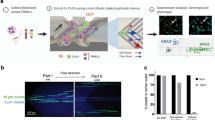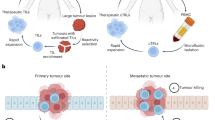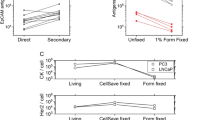Abstract
In this preclinical evaluation we have compared the efficacy of three clinical CD34+enrichment procedures with respect to purity, yield and recovery, as well as risk of selective loss of CD34+ lineage-specific subsets. The three devices work by different principles and have several different manipulation steps: The magnetic field separator uses paramagnetic iron-dextran particles; the magnetic microbead selection is based on the advantage of a large surface area for immobilisation of the monoclonal antibody within a very small volume; the original immunoabsorption technique is based on the use of biotinylated antibody applied to a column of avidin-coated sephadex beads. The results of this evaluation gave a median purity 96% (88–98%), 86% (62–97%), and 49% (18–85%), and median yield of 65% (54–100%), 40% (21–74%), and 30% (8–55%), respectively. Subset analysis recognised a selective loss of CD34+/61+ after enrichment, most likely due to class I–II antibodies used for the enrichment step or, alternatively, nonspecific binding of megakaryocytic progenitors. Tumour cell spiking experiments on a clinical scale documented an expected 2–4 log reduction resulting in a number of potentially malignant cells in the CD34 enriched product. Our data support four major conclusions: First, that magnetic field separation is superior to magnetic beads and chromatography selection, mainly due to the risk of cell loss and insufficient recovery with the two latter methods. Second, that late differentiated progenitors with CD34 class III epitopes present are lost during the enrichment procedures. The third major conclusion is that chromatography selection results in a selective loss of CD34bright cells, which are most likely uncommitted early progenitors. This was an unexpected finding which may be a consequence of an imbalance between the strong forces between biotin–avidin and insufficient physical manipulation for CD34+ cell release. Finally, the data document that CD34 selection alone is an inappropriate way to eliminate tumour cells due to the uncontrolled variables and the inconsistent outcome. The only products which can be expected to be purged free of tumour cells are the ones with very minimal (<10−5) contamination in the starting products, ie products documented tumour free with the most sensitive techniques for quantitation. If this is not the case, the optimal purging strategy may be a two-step procedure including CD34 selection and subsequent depletion of the tumour cells in question.
This is a preview of subscription content, access via your institution
Access options
Subscribe to this journal
Receive 12 print issues and online access
$259.00 per year
only $21.58 per issue
Buy this article
- Purchase on Springer Link
- Instant access to full article PDF
Prices may be subject to local taxes which are calculated during checkout
Similar content being viewed by others
Author information
Authors and Affiliations
Rights and permissions
About this article
Cite this article
Johnsen, H., Hutchings, M., Taaning, E. et al. Selective loss of progenitor subsets following clinical CD34+ cell enrichment by magnetic field, magnetic beads or chromatography separation. Bone Marrow Transplant 24, 1329–1336 (1999). https://doi.org/10.1038/sj.bmt.1702077
Received:
Accepted:
Published:
Issue Date:
DOI: https://doi.org/10.1038/sj.bmt.1702077



